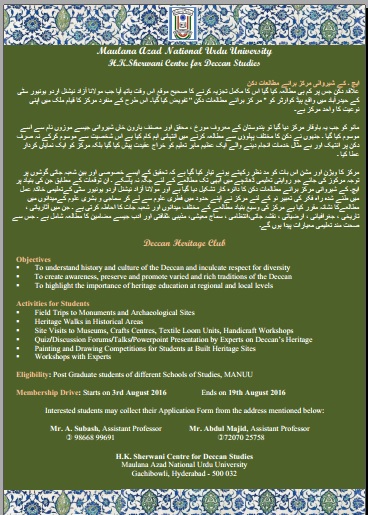Deccan Heritage Club 2016-17

Deccan Heritage Club Members (2016-17)
Trip to Qutb Shahi Tombs
The Deccan Heritage Club took the member-students on their first trip to the Qutb Shahi tombs on 07.09.2016. The students were taken around the tombs complex and explained in detail about the architectural features of each monument. They were also shown how the conservation work that is underway at present is important for restoring the deteriorating and crumbling structures in the precincts.
Trip to Golconda Fort
The H.K.Sherwani Centre for Deccan Studies organized a field trip to Golconda Fort for its member students of Deccan Heritage Club on 13.10.2016. Golconda was the principal capital of the Qutb Shahis and the fort is a testimony to Hyderabad’s glorious past. The students were taken around the fort and were shown ruins of palaces, mosques, hilltop pavilion, stables, warehouse, etc. They were explained in detail about the architectural features and the acoustic and hydraulic technologies which reflect the engineering marvels of the period.
Trip to Bhongir Fort
The H.K.Sherwani Centre for Deccan Studies organized a field trip to Bhongir Fort for its member students of Deccan Heritage Club on 19th November 2016. The Bhongir fort was built in the 10th century on an isolated monolithic rock by the Western Chalukyan ruler Tribhuvanamalla Vikramaditya VI. It was later occupied by the Kakatiyas. The fort is known for its impregnability and architectural marvels. The courts inside the fort are beautifully decorated a moat encircles the fort. There is an underground chamber, stables, wells and ponds along with an armoury.
Trip to Paigah Tombs
The H.K. Sherwani Centre for Deccan Studies organised a field trip for the member students of Deccan Heritage Club to Paigah Tombs on 9th February 2017. Constructed between 1787 and 1880, the Paigah tombs also known as Maqhbara Shams al-Umara, contain graves of several generations of the Paigah nobles who served Nizams under different capacities. The students were explained in detail about the architecture of the tombs. The stucco technique that is inlaid in mosaic work represent the Mughal, Greek, Persian, Asaf Jahi, Rajasthani and Deccani style of architecture. The geometrical patterns followed in the designing of these tombs are unique and not seen anywhere else in the world.

Deccan Heritage Club Members
The inaugural meeting of Deccan Heritage Club was held on 27th August 2015 at H.K. Sherwani Centre for Deccan Studies. The students, who were enrolled as members, from different streams of disciplines were introduced to the annual Activity Plan of the club and to Deccan’s built heritage through a power point presentation by the faculty of H.K. Sherwani Centre for Deccan Studies. The presentation was a rich visual description of architectural heritage of the Deccan with examples ranging from Vijayanagar, Bahmanis, Adil Shahis, Qutb Shahis, Marathas and Asaf Jahis.
The H.K. Sherwani Centre for Deccan Studies in association with Aga Khan Trust for Culture organised a field trip for the member students of Deccan Heritage Club to the Qutb Shahi tombs on 10th September 2015. The students were taken around the tombs complex and explained in detail about the architectural features of each monument. They were also shown how the conservation work that is underway at present is important for restoring the deteriorating and crumbling structures in the precincts.
The H.K. Sherwani Centre for Deccan Studies organised a field trip for the member students of Deccan Heritage Club to Medak Church on 31st October 2015 to study the Indo-European Gothic architecture that developed during the Asaf Jahi times. The students were taken around the Church and were explained in detail about the foundation of the Cathedral and its architectural features. The Cathedral is recognized not only for its stupendous size but also for its interior splendour. Constructed in 1914 by Rev. Charles Walker Posnett, the Cathedral is known for its 173 ft. high Bell Tower and stained glass windows which show the three important phases in Jesus Christ’s life - Nativity, Crucifixion and Ascension. The Junior Pastor Bro. Karunakar interacted with the students and donated copies of Urdu version of New Testament titled Naya Ahad Nama.
The H.K. Sherwani Centre for Deccan Studies organised a field trip for the member students of Deccan Heritage Club to Bhongir fort, Thousand Pillar Temple and Warangal fort on 25th November 2015. The bus started from MANUU campus with the students at 8 am and returned by 9 pm. They were first shown the Bhongir fort built in the 10th century by the Western Chalukyas. The students were then taken to the Thousand Pillar Temple which was constructed in 1163 CE by the Kakatiya ruler Ganapatideva and explained about the different aspects of Kakatiyan architecture. Thereafter, they were taken to Warangal fort where they were shown the ruins of the fort and the restoration work carried on by Archaeological Survey of India was explained to them in detail.
The H.K. Sherwani Centre for Deccan Studies organised a field trip for the member students of Deccan Heritage Club to Paigah Tombs and Hayathnagar Sarai on 13th February 2016. The students were first shown the Paigah tombs also known as Maqhbara Shams al-Umara. Constructed between 1787 and 1880, the Paigah tombs contain graves of several generations of the Paigah nobles who served Nizams under different capacities. The students were explained in detail about the architecture of the tombs. The stucco technique that is inlaid in mosaic work represent the Mughal, Greek, Persian, Asaf Jahi, Rajasthani and Deccani style of architecture. The geometrical patterns followed in the designing of these tombs are unique and not seen anywhere else in the world. The students were then taken to Hayathnagar sarai and the Hayath Bakshi begum mosque that were constructed in 1672 during the reign of fifth Golconda sultan, Abdullah Qutb Shah. The mosque was built in Qutb Shahi architecture; with a huge sarai, a rest house for the travellers and Hathi Bowli, a very large well on the north-east of the mosque from where water used be drawn.